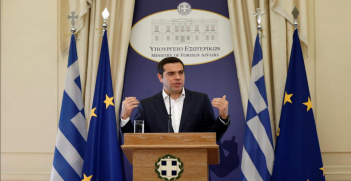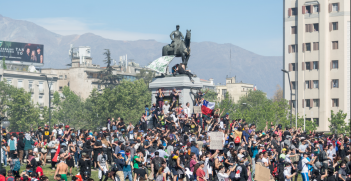ISIS: Assessing Rumiyah

The propaganda released by ISIS since late 2015 provides a fascinating case study of how a group in politico-military decline uses messaging to coax friends and foes into fixating upon and exaggerating its strengths while ignoring, dismissing or reframing its failures. In this context, the group’s latest English-language publication, Rumiyah, provides an insight into the role of Australians in ISIS and is a reminder of how misguided counter-terrorism initiatives can do more to assist extremist appeals than counter them.
Through 2014-15 ISIS propaganda framed politico-military successes as manifestations of divine approval and their defeat of enemies as evidence of divine disapproval. While ISIS narratives have continued to emphasise that their caliphate remains and is addressing its citizens needs, these messages have been increasingly partnered (and often overshadowed) by narratives that frame material losses as fleeting and divinely foretold and therefore part of a master plan that requires the unceasing commitment of true believers to ISIS’ perpetual war. ISIS’ latest propaganda effort to reach English-speaking audiences, Rumiyah (Rome), is a mix of mostly rehashed content from its Arabic-language magazine Al-Naba and some articles specifically for Western audiences typical of its other English-language magazine Dabiq. It therefore must be understood within this strategic and historical context.
Expanding or contracting propaganda campaign?
The first issue of Rumiyah was released in English and several other languages such as Turkish and French. Much of its content is translated from ISIS’ primary Arabic newsletter which suggests that Rumiyah is an attempt to more efficiently disseminate news from its heartlands to multilingual audiences. Time will tell whether Rumiyah is part of an expanding or contracting ISIS propaganda strategy. If Rumiyah is used to augment long-running formats, such as its English magazine Dabiq or its Turkish Constantinople magazine, Rumiyah may be part of an expanding ISIS propaganda output in response to its losses. However, if Rumiyah’s role is as a replacement for these offerings then this would suggest that ISIS is transitioning to a downsized (i.e. more resource, time and energy efficient) propaganda strategy.
Jihad through the Dar al-Kufr
Rumiyah’s 38 pages are largely designed to show audiences that the caliphate remains and that “Muslims currently living in Dar al-Kufr [Land of Disbelievers] must be reminded that the blood of the disbelievers is halal”. The sheer diversity of Rumiyah’s messaging works to leverage a spectrum of audience motivations to shape their perceptions, polarise their support and drive behavioral changes. Rumiyah’s contents feature jurisprudentially focused arguments (‘The religion of Islam and the Jama’ah of the Muslims”), inspirational stories of ISIS militants (“Among the Believers are Men: Abu Mansur al-Muhajir”), promotion of ISIS’ politico-military activities (“Interview with the Amir of the Central Office for Investigating Grievances and ‘Operations’”), manipulation of cultural traditions (“The Virtue of the 10 Days of Dhul-Hijjah and the Acts of Worship Therein”) and perpetuation of perceptions of crisis (“The Wicked Scholars are Cursed”) to influence supporters’ behaviour. It deploys narratives which place current events and actions into a broader strategic, historic and cosmic context (“The Kafir’s blood is halal for you, so shed it”). The magazine’s central message is clear: regardless of material losses, ISIS’ war is fundamentally a battle of opposing values and is never-ending. The magazine not only referred to the recent death of its charismatic spokesman Abu Muhammad al-Adnani but the deaths of Abu Musab al-Zarqawi and even the Prophet Muhammad as evidence that human losses can never derail their divinely sanctioned plan.
ISIS’ message to Australia
Propaganda analysis can offer valuable insights into what issues and events its producers see as pertinent to their target audiences and therefore as ripe to be leveraged via strategically designed messaging. Consequently, propaganda analysis can be a useful way to both inform more effective counter-strategies and identify how misguided strategies may be inadvertently contributing to the appeal of extremists. Rumiyah’s first “Among the Believers are Men” offering, a regular segment in ISIS’ Dabiq magazine, focused on the life and death of Australian Ezzit Raad (aka Abu Mansur al-Muhajir) and is potentially telling in this regard. The article showcases many of the trademarks of ISIS’ approach to propaganda. With a narrative that is designed to simultaneously exacerbate its audiences’ perceptions of crisis yet inspire and empower them to take action, it portrays Raad and other Australians of the caliphate as ordinary mortals who abandoned everything for an extraordinary cosmic struggle. While much has been made of the fact that the article tells Australian supporters to “kill them on the streets of Brunswick, Broadmeadows, Bankstown, and Bondi. Kill them at the MCG, the SCG, the Opera House, and even in their backyards”, far more insightful is Rumiyah’s portrayal of Australia’s domestic war on terrorism—notably the myopic focus of counter-terrorism efforts on Australia’s Muslim communities with a fusion of ‘hard’ and ‘soft’ strategies enabled by unprecedented legislation. The article’s description of these dynamics is general enough to resonate with audiences from around the world yet contains enough specificity for Australians, but particularly Victorians, to recognise local nuances.
While it may seem ironic that ISIS would highlight Australia’s use of “new, retrospective anti-terrorism laws” or government involvement in advocating moderate Islam championed by supposedly moderate leaders in Australian Muslim communities, ISIS do so because they know that it will resonate with target audiences. They are not unique. Al-Qaeda in the Arabian Peninsula regularly deploy this strategy in their English-language Inspire magazine. As I have argued previously, when secular governments implement ideology-centric countering violent extremism (CVE) programs that prescribe a moderate Islam typically championed by selected moderate Muslim community figures, the programs tend to act as catalysts rather than buffers of radicalisation. Such strategies tend to not only undermine the credibility of those moderates involved in the program as government lackeys but more broadly discredits anyone advocating such an interpretation as champions of a ‘government Islam’. Moreover, the implementation of such strategies tends to give veracity to, rather than counteract, militant Islamist messages. The result can be a cycle of compounding negative returns with militant narratives warning of a ‘government-sanctioned Islam’ increasingly resonating while those moderate voices so essential to countering extremism lose credibility and legitimacy.
Such CVE initiatives in Australia are not new (see here) but they are predated by militant Islamist warnings of such initiatives. Anwar Al-Awlaki, who is referenced in the Rumiyah article and is regularly identified as a significant influence upon Islamist-inspired Western ‘lone wolves’, warned of such strategies in a 2008 lecture titled “The Battle of Hearts and Minds”. Overall, Rumiyah’s message to Australia is a disturbing insight into the role of Australians in ISIS and testimony to the skilled propagandists operating within the organisation. But it is also a reminder of how misguided counter-terrorism initiatives can do more to assist extremist appeals than counter them.
Haroro J. Ingram is the winner of the AIIA’s Research Impact Award for 2016. He is a research fellow with the Australian National University and a research associate with the International Centre for Counter-terrorism – The Hague. This article is published under a Creative Common Licence and may be republished with attribution.





